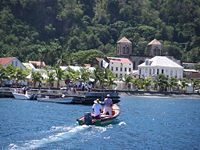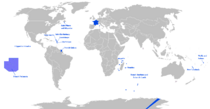Martinique
| Région Martinique | ||
|---|---|---|
|
[[Image:|115px|Logo of Martinique]] | |
| Unofficial region flag | Region logo | |
| Location | ||
|
||
| Administration | ||
| Capital | Fort-de-France | |
| Regional President | Alfred Marie-Jeanne (MIM) (since 1998) |
|
| Departments | Martinique | |
| Arrondissements | 4 | |
| Cantons | 45 | |
| Communes | 34 | |
| Statistics | ||
| Land area1 | 1,128 km² | |
| Population | (Ranked 24th) | |
| - January 1, 2007 est. | 401,000 | |
| - March 8, 1999 census | 381,427 | |
| - Density (2007) | 355/km² | |
| 1 French Land Register data, which exclude lakes, ponds, and glaciers larger than 1 km² (0.386 sq. mi. or 247 acres) as well as the estuaries of rivers |
||
Martinique is an island in the eastern Caribbean Sea, having a land area of 1,128 km². It is an overseas department of France. As with the other overseas departments, Martinique is also one of the twenty-six regions of France (being an overseas region) and an integral part of the Republic. As part of France, Martinique is part of the European Union, and its currency is the euro. Its official language is French, although almost all of its inhabitants also speak Antillean Creole (Créole Martiniquais). Martinique is pictured on all euro banknotes, on the reverse at the bottom of each note, right of the Greek ΕΥΡΩ (EURO) next to the denomination.
- Largest urban areas: Fort-de-France (134,727 inhabitants in 1999, 35% of Martinique's population), Le Lamentin (35,460 in 1999), Sainte-Marie (32,988 in 1999), Le Robert (31,905 in 1999)
- Population: 381,427 inhabitants after the census of 1999 (359,572 en 1990), estimated 401,000 in January 2007.
- Population density: 338 inhab./km² (1999, estimated 354 in 2006)
- Urban population: 42%
- Life expectancy: 79 years (men) and 82 (women) (2000)
- Official language: French
- Principal religion: Roman Catholicism
- GDP/inhab.: €19,050 in 2006, i.e. US$23,931 at 2006 market exchange rates[1]
- Total GDP: €7.65 billion in 2006, i.e. US$9.61 billion at 2006 market exchange rates[1]
- Exports: €606 million (2006)[1]
- Imports: €2,584 million (2006)[1]
- Principal suppliers: Metropolitan France, European Union, Latin America
- Unemployment rate: 23% (2004, (without taking into account "non-declared" revenues). 26,3% in 2000).
Contents |
Geography

Politics
The inhabitants of Martinique are French citizens with full political and legal rights. Martinique sends four deputies to the French National Assembly and two senators to the French Senate. The President of France is Nicolas Sarkozy.
Overview
- Surface area: 1,130 km² (length 75 km, width 35 km)
- Status: overseas department since 19 March 1946, overseas region since 1982
- Prefectorial office: Fort-de-France (a total of 34 habitations).
History
Subdivisions
- Further information: Communes of the Martinique department
Environment

The north of the island is mountainous and lushly forested. It features 4 ensembles of dramatic pitons and mornes: the Piton Conil on the extreme North, which dominates the Dominica Channel, the Mount Pelee, an active volcano, the Morne Jacob, and the Pitons du Carbet, an ensemble of 5 beautifully shaped, rainforest covered extinct volcanoes dominating the Bay of Fort de France at 1,196 meters. The most dominating of the island's many beautiful mountains, with 1397 meters, is the infamous volcano Mount Pelée. The volcanic ash has created beautiful grey and black sand beaches in the north (in particular between Anse Ceron and Anse des Gallets), contrasting markedly from the white sands of Les Salines in the south.
The south is more easily traversed, though it still features some impressive geographic features. Because it is easier to travel and because of the many beautiful beaches and food throughout this region, the south receives the bulk of the tourist traffic. The beaches from Pointe de Bout, through Diamant (which features right off the coast the beautiful Roche de Diamant), St. Luce, the town of St. Anne all the way down to Les Salines are very popular.
Demographics
Historical population
| 1700 estimate |
1738 estimate |
1848 estimate |
1869 estimate |
1873 estimate |
1878 estimate |
1883 estimate |
1888 estimate |
1893 estimate |
|---|---|---|---|---|---|---|---|---|
| 24,000 | 74,000 | 120,400 | 152,925 | 157,805 | 162,861 | 167,119 | 175,863 | 189,599 |
| 1900 estimate |
1954 census |
1961 census |
1967 census |
1974 census |
1982 census |
1990 census |
1999 census |
2007 estimate |
| 203,781 | 239,130 | 292,062 | 320,030 | 324,832 | 328,566 | 359,572 | 381,427 | 401,000 |
| Official figures from past censuses and INSEE estimates. | ||||||||
Culture
- See also: Music of Martinique and Guadeloupe
As an overseas département of France, Martinique's culture blends French and Caribbean influences. The city of Saint-Pierre (destroyed by a volcanic eruption of Mount Pelée), was often referred to as the Paris of the Lesser Antilles. Following traditional French custom, many businesses close at midday, then reopen later in the afternoon. The official language is French, although many Martinicans speak Martinican Creole, a subdivision of Antillean Creole virtually identical to the varieties spoken in neighbouring English-speaking islands of Saint Lucia and Dominica. Mostly based on French and African languages, Martinique's creole also incorporates a few elements of English, Spanish, Portuguese. Originally passed down through oral storytelling traditions, it continues to be used more often in speech than in writing. Its use is predominant within friends and the family cell. Though it is normally not to be used in professional situations, it is being increasingly used in the media and by politicians as a way to redeem national identity and by fear from a complete cultural assimilation by mainland France. The local Creole is intelligible to someone who speaks Standard French and is becoming closer to Standard French.
Most of Martinique's population is descended from African slaves brought to work on sugar plantations during the colonial era, generally mixed with some French, Amerindian, Indian (Tamil), Lebanese or Chinese elements. Between 5 to 10% of the population is of Eastern Indian (Tamil) origin. The island also boasts a small Syro-Lebanese community, a small but increasing Chinese community, and the "Beke" community, White descendants from the first French and British settlers, which still dominate parts of the Agricultural and Trade sectors. The Beke people (which total around 5,000 people in the island, most of them of aristocratic origin) generally live in mansions on the Atlantic coast of the island (mostly in the François - Cap Est district). In addition to the island population, the island hosts a metropolitan French community, most of which lives on the island on a temporary basis (generally from 3 to 5 years).
There are an estimated 250,000 people of Martinican origin living in mainland France, most of them in the Parisian region.
Today, the island enjoys a higher standard of living than most other Caribbean countries. The finest French products are easily available, from Chanel fashions to Limoges porcelain. Studying in the métropole is common for young adults. For the rest of the French, Martinique has been a vacation hotspot for many years, attracting both upper-class and more budget-conscious travelers.
Martinique has a hybrid cuisine, mixing elements of African, French, and Asian traditions. One of its most famous dishes is the Colombo, a unique curry of chicken (curry chicken), meat or fish with vegetables, spiced with a distinctive masala of Bengali or Tamil origins, acidulated with tamarind and often containing wine, coconut milk, and rum. There is also a strong tradition of créole desserts and cakes, often employing pineapple, rum, and a wide range of local ingredients.
Martinique in Popular Culture
- Martinique was the main setting of the 1944 film To Have and Have Not starring Humphrey Bogart and Lauren Bacall.
- The island is mentioned in the song Uffington wassail by Half Man Half Biscuit.
- In the gothic soap opera Dark Shadows, the characters of Angelique Bouchard Collins, Josette du Pres, and Josette's family are from Martinique.
- Martinique was also featured in the 1999 remake of "The Thomas Crown Affair," and in the movie "Sugar Cane Alley".
- It is also mentioned in the Beach Boys hit "Kokomo" with the line "To Martinique, that Montserrat mystique"
Miscellaneous topics


- Economy of Martinique
- Flag of Martinique
- List of media outlets in Martinique
- Communications in Martinique
- Créole Patois
- Holidays in Martinique
- Military defense is the responsibility of France.
Military branches: French forces (Army, Navy, Air force), Gendarmerie - Transportation in Martinique
- Aimé Césaire
- Scouts et Guides de Martinique
- Frantz Fanon
- Édouard Glissant
- Créolité
- Négritude
- Ronny Turiaf
- Philémond-Montout Jimmy
- Patrick Chamoiseau
- Guy Deslaurier
External links
- Martinique Tourism Authority - Official site
- Prefecture Région Martinique - Official site
- Regional Council of Martinique Official site
- Martinique travel guide from Wikitravel
- Martinique maps, collection of assorted Martinique maps
- Simon Jean-Joseph - the European rally champion from Martinique
- A glance at Martinique - Documentary by Ali Sattarpour
References
- ↑ 1.0 1.1 1.2 1.3 (French) INSEE-CEROM. "Les comptes économiques de la Martinique en 2006". Retrieved on 2008-01-13.
|
||||||||||||||||||||||||||||||||||||||||
|
|||||||||||||
|
|||||||||||||||||||||||||||||||||||||
|
|||||||||||||||||||||||||
|
|||||
|
|||||||||||||||||||||||||||||||||||||
|
|||||||||||||||||





